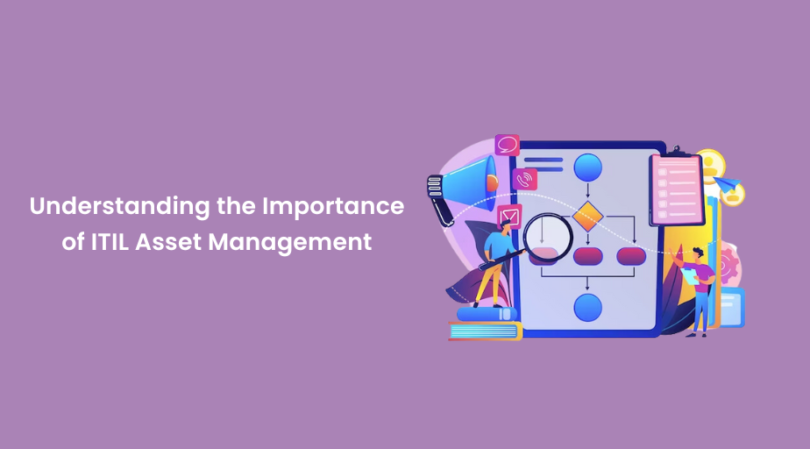Effective IT asset management is essential for organisations seeking to streamline their operations, reduce costs, and improve overall productivity. ITIL Asset Management (Information Technology Infrastructure Library) provides a comprehensive strategy for managing an organisation’s IT assets throughout its lifespan. IT workers who receive an ITIL Certification get important insights into the ideas and practises of ITIL Asset Management, allowing them to execute successful asset management strategies. In this blog, we will look at the importance of ITIL Asset Management and how ITIL Certification may provide professionals with the knowledge they need to maximise the value of their IT assets.
Table of contents
- What is ITIL Asset Management?
- The Importance of ITIL Asset Management
- ITIL Certification: Empowering Professionals in Asset Management
- Implementing ITIL Asset Management
- Conclusion
What is ITIL Asset Management?
ITIL is a set of best practices and recommendations for IT service management (ITSM) that have achieved global traction. It provides a formal framework for aligning IT services with business goals and improving service performance. Asset management is a critical component of ITIL. It entails identifying, tracking, and maintaining an organisation’s IT assets, such as hardware, software, licences, and configurations, throughout their existence.
The Importance of ITIL Asset Management
ITIL Asset Management allows organisations to best use their IT assets. Organisations may prevent wasteful acquisitions and ensure that assets are adequately utilised by being thoroughly aware of their assets and their use.
Asset management assists organisations in reducing wasteful IT asset expenditures. ITIL Asset Management aids to cost efficiency and financial savings by reducing over-provisioning and minimising the expenses associated with underutilised assets.
ITIL Asset Management ensures that organisations meet licencing agreements and other regulatory obligations. It offers a systematic strategy for tracking licences, monitoring software usage, and ensuring legal compliance.
Organisations may make educated choices about their IT infrastructure, procurement, and future investments using the full asset data provided by ITIL Asset Management. This data-driven approach aids strategic planning and risk management.
Asset management is crucial to service delivery. It guarantees that the appropriate IT assets are available when required, reducing downtime and improving overall service dependability.
ITIL Certification: Empowering Professionals in Asset Management
These are some of the most important features of ITIL certification:
- ITIL Certification provides IT workers with a thorough grasp of the ITIL framework, including the role of Asset Management in optimising IT service delivery.
- ITIL Certification equips professionals with industry best practices in IT Asset Management. They learn how to effectively apply these practices to their organisation’s needs.
- ITIL Certification provides professionals with insights into how IT services may be aligned with the company’s strategic objectives, ensuring that IT assets are deployed and managed to meet business goals.
- ITIL Asset handling aids in the effective handling of incidents and problems. Certified experts understand how to correlate occurrences and issues to particular assets, allowing faster responses and more accurate investigation of root causes.
- Change management is an important part of ITIL, and Asset Management plays an important role in managing changes to IT assets. ITIL Certification prepares professionals to successfully manage change management procedures.
Implementing ITIL Asset Management
Steps to implement ITIL asset management:
- Begin by identifying and categorising all of the organisation’s IT assets. Hardware, software, licences, and configurations are all included.
- Implement a systematic asset management approach that spans the entire asset lifespan, from acquisition to retirement or disposal.
- A CMDB acts as a central repository for asset data. Create and keep a CMDB to ensure accurate and up-to-date asset data.
- Define roles and responsibilities for managing IT assets. Delegate asset tracking, maintenance, and disposal to specified persons or teams.
- Conduct frequent audits to guarantee asset data accuracy and compliance. Create reports that offer information about asset utilisation and performance.
Conclusion
ITIL Asset Management is an important component of IT service management since it allows organisations to optimise their IT assets and improve overall efficiency. IT workers that get ITIL Certification receive the competence needed to develop successful Asset Management strategies and integrate IT services with business objectives. Organisations may expedite service delivery, decrease costs, and make informed decisions about their IT infrastructure by utilising ITIL best practices. Embracing ITIL Asset Management and investing in ITIL Certification enables professionals to maximise the value of their IT assets and drive organisational success in the continuously changing world of technology and IT service management.








Leave a Comment
You must be logged in to post a comment.